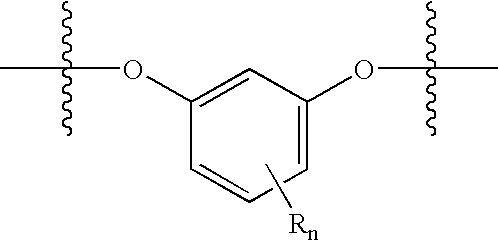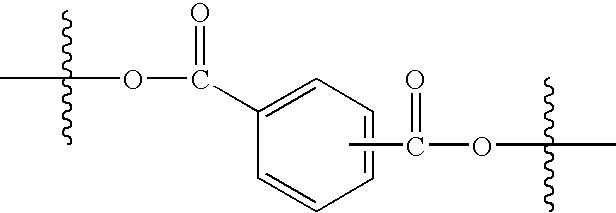Formable thermoplastic multi-layer laminate, a formed multi-layer laminate, an article, and a method of making an article
a thermoplastic multi-layer laminate and multi-layer technology, applied in the field of formable thermoplastic multi-layer laminate, can solve the problems of affecting the mechanical properties of thermoset materials, and imperfections in the surface of glass fibers
- Summary
- Abstract
- Description
- Claims
- Application Information
AI Technical Summary
Benefits of technology
Problems solved by technology
Method used
Image
Examples
examples 1
[0173] Four multi-layer laminates having different tie-layer compositions having a thermoplastic blend comprising ASA / SAN were prepared. Each laminate was made of an outer layer of an iso terephthalic resorcinol / bisphenol A copolymer, commercially available from GE Plastics as ITR-#RL7577, a middle layer of a polycarbonate homopolymer prepared from bis-phenol-A and a carbonyl chloride, commercially available as LEXAN.RTM. 131 (Samples 1 & 2), LEXAN.RTM.100 (100 (Sample 3), and an inner tie-layer consisting of a blend of polycarbonate (PC), acrylonitrile-styrene- acrylate graft copolymer (ASA) and styrene-acrylonitrile copolymer (SAN) of varying proportions as set forth in Table 1. The average thickness of the outer layer was from 5 to 15 mils, the average thickness of the middle layer was from 15 to 40 mils, and the average thickness of the inner layer was from 4 to 15 mils. The total thickness of the laminates was from 30 to 55 mils.
1TABLE 1 Tie Layer Blends & Adhesion (0: no adhes...
example 2
[0181] Multi-layer laminates similar to those produced in Example 1 but having ABS instead of ASA were produced. Each laminate was made of an outer layer of an iso terephthalic resorcinol / bisphenol A copolymer, commercially available from GE Plastics as ITR-#RL7577, a middle layer of a polycarbonate homopolymer prepared from bis-phenol-A and a carbonyl chloride, commercially available as LEXAN.RTM. EXRL0065, and an inner tie-layer consisting of a blend of polycarbonate (PC), acrylonitrile-butadiene-styrene graft copolymer (ABS) and styrene-acrylonitrile copolymer (SAN) of varying proportions as set forth in Table 2. The average thickness of the outer layer was from 5 to 15 mils, the average thickness of the middle layer was from 15 to 40 mils, and the average thickness of the inner layer was from 4 to 15 mils. The total thickness of the laminates was from 30 to 55 mils.
2TABLE 2 Tie Layer Blends & Adhesion Peel Test Average / Std Sample PC (%) ABS / SAN (%) dev 1 51 19 / 30 21.1 / 5 2 73 14 / ...
example 3
[0185] A multi-layer laminate was made according to sample 4 of Example 2, except that about 0.3% by weight of the SEENOX stabilizer was added to the inner tie-layer composition. Peel strength was evaluated as per Examples 1 and 2. The initiation peel strength of the inner tie-layer to the middle layer was about 32, while the propagation peel strength was about 13 lb / in to about 14 lb / in. After LFI-PU foam was applied as per Examples 1 and 2, the peel strength of the inner tie-layer to the foam was evaluated. The initiation peel strength was about 25 lb / in, while the trength was about 16 lb / in.
[0186] The multi-layer laminates allow for the production of formed articles having the surface quality and appearance necessary for exterior automotive parts while simultaneously providing improved adhesion to a substrate. Finally, the multi-layer laminates are advantageous in that they can be manufactured by co-extrusion.
PUM
| Property | Measurement | Unit |
|---|---|---|
| thickness | aaaaa | aaaaa |
| boiling point | aaaaa | aaaaa |
| temperature | aaaaa | aaaaa |
Abstract
Description
Claims
Application Information
 Login to View More
Login to View More - R&D
- Intellectual Property
- Life Sciences
- Materials
- Tech Scout
- Unparalleled Data Quality
- Higher Quality Content
- 60% Fewer Hallucinations
Browse by: Latest US Patents, China's latest patents, Technical Efficacy Thesaurus, Application Domain, Technology Topic, Popular Technical Reports.
© 2025 PatSnap. All rights reserved.Legal|Privacy policy|Modern Slavery Act Transparency Statement|Sitemap|About US| Contact US: help@patsnap.com



